[English] 日本語
 Yorodumi
Yorodumi- PDB-4aa6: The oestrogen receptor recognizes an imperfectly palindromic resp... -
+ Open data
Open data
- Basic information
Basic information
| Entry | Database: PDB / ID: 4aa6 | ||||||
|---|---|---|---|---|---|---|---|
| Title | The oestrogen receptor recognizes an imperfectly palindromic response element through an alternative side-chain conformation | ||||||
 Components Components |
| ||||||
 Keywords Keywords | TRANSCRIPTION/DNA / TRANSCRIPTION-DNA COMPLEX / ESTROGEN / ESTROGEN RECEPTOR | ||||||
| Function / homology |  Function and homology information Function and homology informationregulation of epithelial cell apoptotic process / antral ovarian follicle growth / regulation of branching involved in prostate gland morphogenesis / RUNX1 regulates transcription of genes involved in WNT signaling / RUNX1 regulates estrogen receptor mediated transcription / regulation of toll-like receptor signaling pathway / nuclear estrogen receptor activity / epithelial cell development / steroid hormone receptor signaling pathway / epithelial cell proliferation involved in mammary gland duct elongation ...regulation of epithelial cell apoptotic process / antral ovarian follicle growth / regulation of branching involved in prostate gland morphogenesis / RUNX1 regulates transcription of genes involved in WNT signaling / RUNX1 regulates estrogen receptor mediated transcription / regulation of toll-like receptor signaling pathway / nuclear estrogen receptor activity / epithelial cell development / steroid hormone receptor signaling pathway / epithelial cell proliferation involved in mammary gland duct elongation / prostate epithelial cord elongation / prostate epithelial cord arborization involved in prostate glandular acinus morphogenesis / mammary gland branching involved in pregnancy / uterus development / negative regulation of smooth muscle cell apoptotic process / vagina development / TFIIB-class transcription factor binding / androgen metabolic process / mammary gland alveolus development / cellular response to estrogen stimulus / estrogen response element binding / Mitochondrial unfolded protein response (UPRmt) / nuclear receptor-mediated steroid hormone signaling pathway / positive regulation of DNA-binding transcription factor activity / negative regulation of DNA-binding transcription factor activity / Nuclear signaling by ERBB4 / RNA polymerase II preinitiation complex assembly / positive regulation of nitric-oxide synthase activity / estrogen receptor signaling pathway / protein localization to chromatin / steroid binding / 14-3-3 protein binding / TFAP2 (AP-2) family regulates transcription of growth factors and their receptors / negative regulation of canonical NF-kappaB signal transduction / negative regulation of miRNA transcription / ESR-mediated signaling / TBP-class protein binding / nitric-oxide synthase regulator activity / nuclear estrogen receptor binding / transcription corepressor binding / transcription coregulator binding / stem cell differentiation / SUMOylation of intracellular receptors / cellular response to estradiol stimulus / euchromatin / beta-catenin binding / Nuclear Receptor transcription pathway / response to estrogen / Regulation of RUNX2 expression and activity / transcription coactivator binding / male gonad development / nuclear receptor activity / Ovarian tumor domain proteases / positive regulation of fibroblast proliferation / Constitutive Signaling by Aberrant PI3K in Cancer / positive regulation of nitric oxide biosynthetic process / sequence-specific double-stranded DNA binding / response to estradiol / PIP3 activates AKT signaling / positive regulation of cytosolic calcium ion concentration / ATPase binding / PI5P, PP2A and IER3 Regulate PI3K/AKT Signaling / regulation of inflammatory response / DNA-binding transcription activator activity, RNA polymerase II-specific / fibroblast proliferation / phospholipase C-activating G protein-coupled receptor signaling pathway / transcription regulator complex / Estrogen-dependent gene expression / DNA-binding transcription factor activity, RNA polymerase II-specific / calmodulin binding / Extra-nuclear estrogen signaling / chromatin remodeling / RNA polymerase II cis-regulatory region sequence-specific DNA binding / DNA-binding transcription factor activity / negative regulation of gene expression / chromatin binding / regulation of transcription by RNA polymerase II / protein kinase binding / regulation of DNA-templated transcription / chromatin / positive regulation of DNA-templated transcription / enzyme binding / negative regulation of transcription by RNA polymerase II / Golgi apparatus / signal transduction / positive regulation of transcription by RNA polymerase II / protein-containing complex / zinc ion binding / nucleoplasm / identical protein binding / nucleus / membrane / plasma membrane / cytosol / cytoplasm Similarity search - Function | ||||||
| Biological species |  HOMO SAPIENS (human) HOMO SAPIENS (human) | ||||||
| Method |  X-RAY DIFFRACTION / OTHER / Resolution: 2.6 Å X-RAY DIFFRACTION / OTHER / Resolution: 2.6 Å | ||||||
 Authors Authors | Schwabe, J.W. / Chapman, L. / Rhodes, D. | ||||||
 Citation Citation |  Journal: Structure / Year: 1995 Journal: Structure / Year: 1995Title: The oestrogen receptor recognizes an imperfectly palindromic response element through an alternative side-chain conformation. Authors: Schwabe, J.W. / Chapman, L. / Rhodes, D. | ||||||
| History |
|
- Structure visualization
Structure visualization
| Structure viewer | Molecule:  Molmil Molmil Jmol/JSmol Jmol/JSmol |
|---|
- Downloads & links
Downloads & links
- Download
Download
| PDBx/mmCIF format |  4aa6.cif.gz 4aa6.cif.gz | 131.4 KB | Display |  PDBx/mmCIF format PDBx/mmCIF format |
|---|---|---|---|---|
| PDB format |  pdb4aa6.ent.gz pdb4aa6.ent.gz | 97.8 KB | Display |  PDB format PDB format |
| PDBx/mmJSON format |  4aa6.json.gz 4aa6.json.gz | Tree view |  PDBx/mmJSON format PDBx/mmJSON format | |
| Others |  Other downloads Other downloads |
-Validation report
| Summary document |  4aa6_validation.pdf.gz 4aa6_validation.pdf.gz | 461.8 KB | Display |  wwPDB validaton report wwPDB validaton report |
|---|---|---|---|---|
| Full document |  4aa6_full_validation.pdf.gz 4aa6_full_validation.pdf.gz | 483.4 KB | Display | |
| Data in XML |  4aa6_validation.xml.gz 4aa6_validation.xml.gz | 18.5 KB | Display | |
| Data in CIF |  4aa6_validation.cif.gz 4aa6_validation.cif.gz | 25.5 KB | Display | |
| Arichive directory |  https://data.pdbj.org/pub/pdb/validation_reports/aa/4aa6 https://data.pdbj.org/pub/pdb/validation_reports/aa/4aa6 ftp://data.pdbj.org/pub/pdb/validation_reports/aa/4aa6 ftp://data.pdbj.org/pub/pdb/validation_reports/aa/4aa6 | HTTPS FTP |
-Related structure data
| Related structure data | |
|---|---|
| Similar structure data |
- Links
Links
- Assembly
Assembly
| Deposited unit | 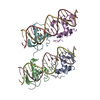
| ||||||||
|---|---|---|---|---|---|---|---|---|---|
| 1 | 
| ||||||||
| 2 | 
| ||||||||
| Unit cell |
|
- Components
Components
| #1: Protein | Mass: 8264.564 Da / Num. of mol.: 4 / Fragment: RESIDUES 182-252 Source method: isolated from a genetically manipulated source Source: (gene. exp.)  HOMO SAPIENS (human) / Production host: HOMO SAPIENS (human) / Production host:  #2: DNA chain | Mass: 5500.580 Da / Num. of mol.: 2 / Source method: obtained synthetically / Source: (synth.)  HOMO SAPIENS (human) HOMO SAPIENS (human)#3: DNA chain | Mass: 5506.577 Da / Num. of mol.: 2 / Source method: obtained synthetically / Source: (synth.)  HOMO SAPIENS (human) HOMO SAPIENS (human)#4: Chemical | ChemComp-ZN / #5: Water | ChemComp-HOH / | |
|---|
-Experimental details
-Experiment
| Experiment | Method:  X-RAY DIFFRACTION X-RAY DIFFRACTION |
|---|
- Sample preparation
Sample preparation
| Crystal | Density Matthews: 3.46 Å3/Da / Density % sol: 64.42 % / Description: NONE |
|---|---|
| Crystal grow | Details: 20 MM MES PH 5.75, 1.8 MM SPERMINE, 2 MICROMOLAR ZINC CHLORIDE, 30 MM SODIUM CHLORIDE, 12 MM CALCIUM CHLORIDE, 10% MPD |
-Data collection
| Diffraction | Mean temperature: 100 K |
|---|---|
| Diffraction source | Source:  ROTATING ANODE / Wavelength: 1.54 ROTATING ANODE / Wavelength: 1.54 |
| Radiation | Protocol: SINGLE WAVELENGTH / Monochromatic (M) / Laue (L): M / Scattering type: x-ray |
| Radiation wavelength | Wavelength: 1.54 Å / Relative weight: 1 |
| Reflection | Resolution: 2.6→15.8 Å / Num. obs: 22960 / % possible obs: 99.5 % / Observed criterion σ(I): 2 / Redundancy: 3.7 % / Rmerge(I) obs: 0.07 |
- Processing
Processing
| Software | Name:  X-PLOR / Classification: refinement X-PLOR / Classification: refinement | ||||||||||||||||||||||||||||||||||||||||||||||||||||||||||||
|---|---|---|---|---|---|---|---|---|---|---|---|---|---|---|---|---|---|---|---|---|---|---|---|---|---|---|---|---|---|---|---|---|---|---|---|---|---|---|---|---|---|---|---|---|---|---|---|---|---|---|---|---|---|---|---|---|---|---|---|---|---|
| Refinement | Method to determine structure: OTHER Starting model: NONE Resolution: 2.6→7 Å / Data cutoff high absF: 0 / Cross valid method: NONE / σ(F): 2 Details: THESE ARE OLD COORDINATES FOR WHICH WE DO NOT HAVE ALL OF THE INFORMATION
| ||||||||||||||||||||||||||||||||||||||||||||||||||||||||||||
| Refinement step | Cycle: LAST / Resolution: 2.6→7 Å
| ||||||||||||||||||||||||||||||||||||||||||||||||||||||||||||
| Refine LS restraints |
|
 Movie
Movie Controller
Controller


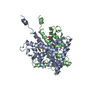

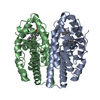

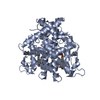

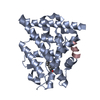


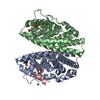
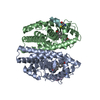
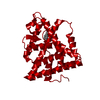





















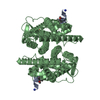
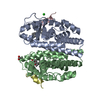


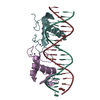
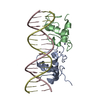

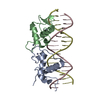


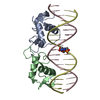
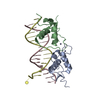

 PDBj
PDBj













































